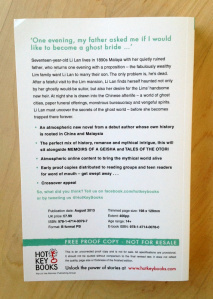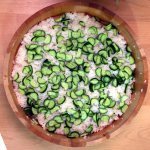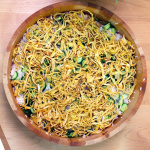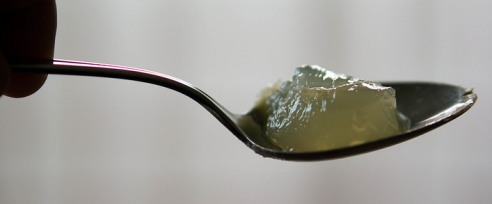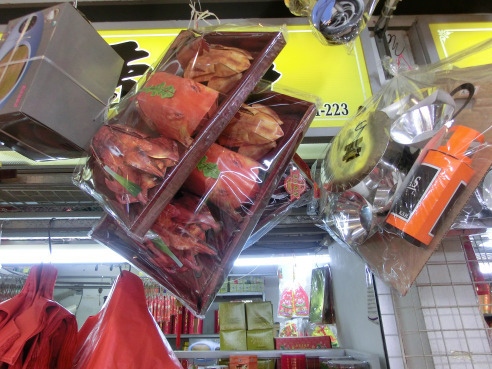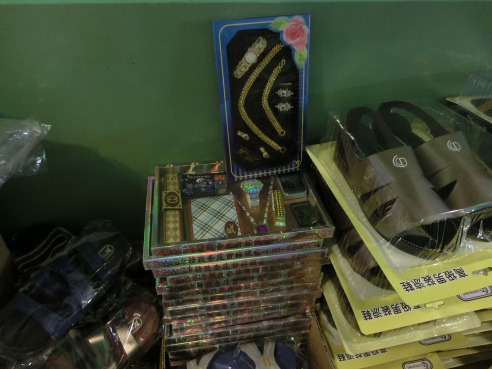Yangsze Choo's Blog, page 5
February 14, 2013
What is a Bound Proof Anyway?
Ever since Christmas and the arrival of the Lego version of Chancellor Palpatine’s Arrest, my 5 and 7 year olds have been convinced that all mail left at our house is potentially from Santa Claus. Laboring under this delusion, they race to the door whenever they hear the thump of a package and proceed to attack it with their small scissors. This is all very annoying, especially if you need to return an item and the box looks like it’s been disemboweled by wild animals.
So when the mailman happened to come by while they were at school, I was already in a good mood to have beaten them to it. There was only a single item — an innocuous-looking padded envelope from London. When I opened it, out slipped a book. Actually, it was MY book. A bound uncorrected proof from my UK publisher without the final cover, but with the form and heft of a real book. I was so excited that I jumped up and down in a most undignified manner, emitting loud squeaks. If anyone had been passing by, they would have heard something like this:
“AAAAaaaahhh! It’s a book! A book! Aaaaaaahhh!” etc.
How should I describe the magical transmutation of thoughts into paper and ink? Flipping through the pages, I glimpsed familiar passages, bits of dialogue that made me cringe, and other parts that I still felt pleased with. I was amazed at how surreal, yet oddly normal it was. It had become a story that you could physically pick up and pass to someone. And when the next person opened it, they too could follow the printed trail of letters into an imaginary world that had come out of my head. I think at this point I started shouting something like “Gutenberg was a genius!” and had to calm myself down by eating a large slice of cake.
This is the UK version, which has a slightly modified text and will be published as Young Adult/Crossover. It’s also what UK book reviewers will be getting as an advance review copy (ARC). At nearly 400 pages or 111K words, it seems like a fairly manageable read; a minor miracle considering that the original manuscript was 170K words without a proper ending. I had little idea of what I was doing when I started writing, but the end result, thanks to rigorous pruning and the intervention of my wonderful agent and editors from William Morrow and Hot Key, is a book and not a gigantic door stop.
I can’t wait to see the US version which is aimed at an adult audience and will be a larger hardcover book. When I do get it, I shall have to make sure that I open it before my kids do!
Snack Suggestions:
Large slice of lemon pound cake
Lots of dark chocolate with raspberries. Events like this require plenty of sugar to fuel them (when my husband came home later, the two of us were bouncing around like demented hamsters).
Thank you so much to everyone who has read this blog or encouraged me on this journey. I’ll have the first chapter up soon so you can have a sneak peek!
What’s the most memorable package you’ve received in the mail?
If you enjoyed this post, please follow my blog or :)


February 11, 2013
Raw Fish = Good Luck
I was talking to some friends from Hong Kong about Chinese New Year specialties when I happened to mention raw fish. They looked at me blankly.
“You know,” I said, “Yee sang. That salad thing with raw fish that you eat at New Year’s.”
When they continued to look puzzled, I had a moment of panic, familiar to Malaysian and Singaporean Chinese, that my Cantonese was simply unintelligible to people from Hong Kong. This is a very real concern because the Cantonese from our part of the world is sprinkled with non-standard words, many of them borrowed from Malay. Every now and then I’ll say something odd and realize that nobody understands me. Then I have to pretend to cough, or look meaningfully out of the window.
 But to return to the question of raw fish. It turns out that this tradition is actually a Malaysian/Singaporean thing and was invented in 1964. The whole business, of course, revolves around the Chinese love for homophones. In Chinese, raw fish sounds like “lots of prosperity” and is served at New Year’s in a salad form. Shredded daikon, carrots, jellyfish, turnips, key lime leaves, pomelo, peanuts and other ingredients are tossed with the fish, typically salmon, as everyone shouts various lucky phrases and stirs it with their chopsticks. Lost in this mish-mash, the minuscule amount of raw fish is further obscured by a sweet sauce, and with everyone tossing and yelling over it, it somehow doesn’t seem quite as appetizing. So every Chinese new year, I’ve taken to making my own lucky version with lots more fish. Basically, I serve chirashizushi instead and so far, none of the guests have complained.
But to return to the question of raw fish. It turns out that this tradition is actually a Malaysian/Singaporean thing and was invented in 1964. The whole business, of course, revolves around the Chinese love for homophones. In Chinese, raw fish sounds like “lots of prosperity” and is served at New Year’s in a salad form. Shredded daikon, carrots, jellyfish, turnips, key lime leaves, pomelo, peanuts and other ingredients are tossed with the fish, typically salmon, as everyone shouts various lucky phrases and stirs it with their chopsticks. Lost in this mish-mash, the minuscule amount of raw fish is further obscured by a sweet sauce, and with everyone tossing and yelling over it, it somehow doesn’t seem quite as appetizing. So every Chinese new year, I’ve taken to making my own lucky version with lots more fish. Basically, I serve chirashizushi instead and so far, none of the guests have complained.
New Year’s Chirashizushi:
This is a fairly easy party dish that looks festive and can be adjusted according to the number of guests. It requires a certain amount of prep work, but most of it can be done ahead of time. For 8 people, about 4 rice cooker cups (these are special measuring cups which come with an electric rice cooker) of uncooked rice should be enough. More if you have big eaters, less if you have low-carb guests.
Ingredients:
Short grained Japanese rice for sushi. Don’t use Jasmine or Basmati. I like new crop (this year’s rice crop) koshihikari rice, much of which is grown in California by Japanese-run corporations and is very good.
Sushi vinegar - you can make your own, or buy this pre-mixed at an Asian grocery. If you buy it, make sure it’s labelled for “sushi” and already has sugar/salt in it.
3-4 Japanese cucumbers or 1 large English cucumber
A package of daikon sprouts. If you can’t find them, try other kinds of sprouts.
Sashimi-quality fish. I buy mine from a Japanese grocery store, where it’s labeled and flash-frozen commercially to kill parasites. Good quality sashimi should also have a point of origin stated on it. Choose whatever fish you like to eat and that looks fresh. This time I used salmon, kampachi (amberjack), salmon roe, and squid, but I also like yellow tail, scallops, and amaebi (raw sweet prawns) if I can get them.
If you don’t want to use raw fish, you can substitute smoked salmon which qualifies as “uncooked” for New Year’s purposes. In fact, you can make a really nice version with smoked salmon, crab or lobster meat, or cooked prawns if you prefer.
4-5 eggs for 8 people.
Condiments: soy sauce and wasabi, Korean seaweed packets for eating it with (I prefer Korean nori to Japanese nori, since the Korean variety is oiled and salted)
Assembly:
Cook the rice in a rice cooker. When done, put it in a large platter and lightly mix the sushi vinegar into it, turning the rice with a paddle and taking care not to squish the grains. Traditionally, you can use a fan to help the steam evaporate and give it a glossy look. If you’re not going to use the sushi rice right away, cover it with a damp towel so it doesn’t dry out.
While the rice is cooking, slice the cucumbers in half lengthwise, then cut into slim half moons. If you’re using the English “hothouse” style cucumbers that come wrapped in plastic, their seeds are more watery than the Japanese variety, so you’ll need to use a small spoon to scrape them out. Rinse the sprouts, pat dry, and cut the roots off if they’re still attached in the packaging.
Make thin egg pancakes (kinshi tamago). Here’s a recipe from Maki, one of my favourite bloggers. I bought her Just Bento cookbook as soon as it was available and highly recommend it.
Rinse the sashimi in cold water and pat dry with a paper towel. Using a very sharp knife and clean cutting board, cut the fish into slices. Don’t worry if it doesn’t look perfect. This is a very forgiving dish in terms of presentation.
Just before eating, start to assemble it. First, spread the rice lightly and evenly over the bottom of your container. Add a layer of cucumbers, then the egg threads, the sashimi, and then finally the sprouts and salmon roe. You can also serve this at birthdays and other celebrations as it looks festive and scales easily!
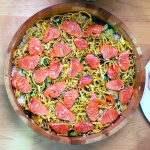
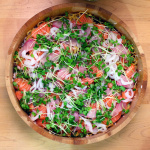
Photo credit for Photo 2: People’s Daily Online
What do you like to eat on New Year’s Day?


February 7, 2013
Cheongsam – the Chinese Diet Aid
Chinese New Year is when a kind of collective madness descends on Chinese people all over the world. No other holiday even comes close. Masses of workers making their once-yearly pilgrimage to the countryside cause transit nightmares in China. In Los Angeles, restaurants and supermarkets shut down. In Malaysia and Singapore, days of cooking culminate in the traditional New Year’s Eve family banquet. Not going home for New Year’s is unthinkable. Well, if you had been disowned you could probably avoid it but even then, I think you would still be expected to show up in the street outside, kneeling in tears for parental forgiveness (the plot of many Chinese soap operas).
Unsurprisingly, all of this eating, mahjong-playing, and giving of hong bao (red cash envelopes) is an invitation to largesse in more ways than one, but I’d like to share a secret diet aid that Chinese women have been relying on for years. All you need to do is squeeze into a body-hugging cheongsam or qipao, which is fortunately always in fashion at this time of year. I recently had to do this when I attended a formal Chinese New Year banquet and discovered, to my dismay, the efficacy of this garment.
But first, a brief history. This high-collared dress is actually not Chinese at all. It’s a derivative of Manchu clothing, which Chinese people were forced to adopt when the Manchus (a non-Chinese tribe from the north) defeated the Ming dynasty in 1644. Originally, Manchu robes were loose and somewhat shapeless, but by the 1920s, they had transformed into the fashionably tight, form-fitting sheath so beloved of Hong Kong movie stars.
The Cheongsam Diet:
A few days prior to the event, try your cheongsam on repeatedly. You will find that no matter how nicely fitted it originally was, it is always too small on the day of the event, so plan accordingly.
On the big day, suck in your stomach and squeeze into your dress. The unforgiving silhouette will cause you to automatically straighten up and adopt the posture that your mother has been nagging you about for years.
Add a pair of dainty high heels. No cheongsam looks good with flats or (horror!) slippers or clogs. I like to think that this echoes the teeter-tottery shoes that Manchu women wore to imitate the bound feet of Chinese women, but the truth is, with a dress like this that’s basically a sausage covering, you should shamelessly exploit all options to appear willowy. (“Willowy” being a favourite classic Chinese description).
A further note about heels — no platforms please! Platforms are the antithesis of “willowy”.
When you arrive at your event, you will discover that it is extremely difficult for you to stand up and sit down without exposing yourself to all the men in the room. This, along with your high heels, will deter you from multiple trips to the buffet table.
If you should actually manage to snag a plate with food, you will be unable to eat large quantities because of the highly restrictive Mandarin collar. I was forced to watch my husband devour the duck on both our plates because I literally could not swallow large mouthfuls.
As I tottered home at the end of a lavish evening, I realized it was the first time in a long while that I hadn’t stuffed myself. Compared to my date who had ingested most of my meal as well as his, I felt relatively bloat-free. Still, the lack of food made me cranky (now I understand why models have perpetual frowns) and sadly, the diet lasted only as long as the dress was worn. Which leads me to think that the cheongsam is only a temporary solution, unless, like Maggie Cheung in the ultimate cheongsam movie In the Mood for Love, you have one for every day of the year.
Suggested Snack:
None. Or weak sips of Chinese tea
Photo credits: 1. Still from the movie “In the Mood for Love”. 2. Clark Gable and Li Lihua, Associated Press Dec. 3, 1954.
Happy new year! If you enjoyed this post,
(My blog giveaway is still running until next Monday!)


February 3, 2013
City of Djinns
(THIS POST HAS A SPECIAL GIVEAWAY AT THE END)
One of the most petrifying driving experiences I had was on a highway in India, when a rapidly approaching dust cloud turned out to be a truck hurtling towards us on the wrong side of the highway. Dumbstruck, I gripped the seat in front of me, but our driver merely swerved to avoid the behemoth and continued blithely on his way.
“What was that?” I said, in a choked voice.
“Lorry, madam.”
Malaysia has more than its share of horrendous drivers, but I had never encountered anything quite like this. Most traffic offences in Malaysia seem to be committed by the tiny Kancil cars, which wedge themselves into motorcycle parking spots and cut you off so sharply that you expect to see your car bleeding. But we had nothing so terrifyingly picturesque as that encounter in Rajasthan. The bright blue sky and dry mustard fields, worked by women in traditional clothes. The flash of the splendidly decorated lorry adorned with painted eyes (not that they seemed much use to it). My driver’s que sera sera attitude, where most Malaysians would be apoplectically reaching for their tire irons. I realize of course, that these were only tourist impressions, and that one would have to live a long time in India before attempting to understand its nuances. Fortunately, I was able to gain a little headway through William Dalrymple’s wonderful City of Djinns.
Now, my bookshelves are primarily groaning with fiction, but this is one of my favourite non-fiction books which has survived many purges. In fact, I ought to quantify this by saying that I originally stole it from my father’s library because I liked it so much and I was sure he wasn’t going to reread it as often as I would. William Dalrymple, a young Englishman who had already won rave reviews for his travel book In Xanadu, which retraced Marco Polo’s route across central Asia, then spent a year living and researching in the city of Delhi. The compulsively readable result is a history of Delhi’s colourful past and present.
Did you know, for example, that Delhi is said to have been built on the ruins of seven dead cities and is now in its eighth incarnation? Or that the Mughal emperors of India were actually descended from the Mongols, thus accounting for their almond-shaped eyes? The repeated rise and fall of this historic city, with its ferocious politics and tragic tales of emperors and slaves, is captured in this deceptively slim book.
I don’t know how William Dalrymple amassed all this knowledge; his research seems to have included not only scholarly sources, but lots of wandering around and chatting with people. Which leads me to believe that in person he must be extraordinarily charming. Or dogged, if he was able to insinuate himself into a house of eunuchs (yes, real eunuchs, and it’s a very sad story). He’s since gone on to write many other award-winning histories, the latest being Return of a King (FT Review), but this book, written when he was only 23, is a fascinating introduction to India.
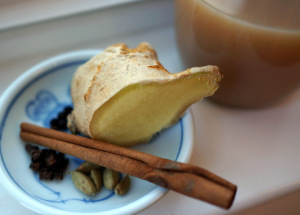 Snack Suggestions to Go With This Book:
Snack Suggestions to Go With This Book:
Samosas and mint sauce
Hot chai tea – here’s a traditional from-scratch recipe
BOOK GIVEAWAY!!
I’m giving away two new (non-stolen) copies of City of Djinns to two lucky winners!
For a week, from Feb 4-11th 2013, if you do any of the following: like my Facebook page, share this link on Facebook, retweet or (or all four!), you’ll be entered into the random book drawing. If you’re retweeting or sharing on FB, please leave a comment on this page so that I’ll know to put your name down. Winners will be announced on Tuesday, Feb 12th, and can be anywhere in the world as long as there’s a way to post a book to you.
What’s your favourite travel book?


January 31, 2013
The Secret of Japanese Mayonnaise
I spent part of my childhood in Japan, which left me with an enduring love for manga and mayonnaise. Specifically, the absolutely delicious Japanese brand of mayonnaise known as Kewpie. Now I know plenty of people make their own homemade mayo, which I’m sure is also extremely tasty, but for those of us can’t eat raw eggs or are just too lazy to whip up a batch, it’s a great option. Kewpie mayo is also beloved by chefs like Momofuku’s David Chang, who called it “the best mayonnaise in the world”(Food & Wine).
What is Kewpie mayonnaise?
If you’ve ever been in an Asian market, you may have noticed some strange, squishy looking bottles with a drawing of a naked baby on them. To make things more bizarre, the bottle is encased in a plastic bag. I don’t know why this is done, since the bottle itself seems to be a perfectly adequate container, but that’s just the way it is. The mayonnaise itself is also different from the typical commercial jarred product. To begin with, it’s made from egg yolks rather than a mix with whole eggs. This gives it a smooth eggy flavour which is more akin to homemade mayo, and a thinner consistency. Kewpie is also sharper and tangier due to its proprietary blend of apple and other vinegars, and contains no sugar.
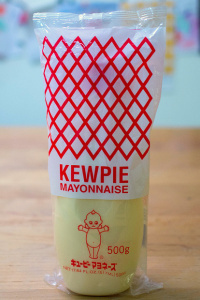
Secret #1 There are actually 2 nozzles on the bottle. The first is a fine nozzle, which allows you to pipe fancy swirls of mayonnaise on top of your hardboiled eggs, and if you unscrew the red top, you’ll find a larger, star shaped nozzle for less dainty work.
Secret #2 Kewpie contains MSG, a flavour enhancer. I’m not against MSG in small quantities–in fact, Cook’s Illustrated Magazine found that chicken stock made with a little MSG was superior than stock made without. The key is restraint, not the handfuls of white crystals that are slung into Chinese restaurant food.
Snack suggestions:
Kewpie can be used wherever normal mayonnaise is deployed, but it really shines in combination with Sriracha sauce. Don’t try it with regular mayo–it makes a weird, blobby concoction. You really need Kewpie for this.
Secret #3 The special “dynamite sauce” used in sushi restaurants is simply Kewpie mayonnaise mixed with Sriracha.
Snack 1. Add a few drops of Sriracha to Kewpie mayo to taste, and use it as a dip for fried chicken (karaage). It’s rather decadent to dip fried chicken in a mayonnaise sauce, but it’s really good!
Snack 2. Make a bite-size scallop hand roll. For this, you need sashimi grade scallops. I prefer to buy them from a Japanese grocery store, where they should be marked “sashimi” and are previously flash-frozen to kill parasites. If you’re preparing sashimi at home, make sure your cutting board is clean (I often sterilize it by pouring a pan of boiling water over it in the sink) and your knife is very sharp.
Rinse the scallops in cold water and pat dry. They should have a sweet, fresh scent that makes you want to devour them. If they don’t smell good, don’t eat them.
Cut first across the grain (slice horizontally, like splitting a cake for filling) and then into quarters.
Mix lightly with finely chopped green onions, a squirt of Kewpie and a few drops of Sriracha to taste.
Eat with Korean seasoned seaweed with a little rice, sliced green cucumber, and salmon caviar for a truly luxurious touch. I prefer Korean seaweed to Japanese in this instance because it’s thinner, crispier, and has a bit of salt and oil in it. Try it and compare!
Good books to pair with this – Haruki Murakami’s “A Wild Sheep Chase”, set partly in Hokkaido where many sashimi-grade scallops come from, and some ice cold Sapporo beer.
What do you like to eat with mayonnaise?


January 28, 2013
The Charms of Liverwurst and Crickets
When I first arrived in America, I was so pleased that I could read all the signs that were in English that it never occurred to me that the average American would not have heard of Enid Blyton. I was thunderstruck. One of the bastions of literature for small children in ex-British colonies all over the world was virtually unknown here, together with creations such as Noddy, the Secret Seven, the Five Find Outers…
Of course, there was some overlap. Americans seemed well acquainted with Roald Dahl and classics such as Frances Hodgson Burnett’s A Little Princess, but there were gaping holes. Instead, they had all been reading books like the Little House series, Judy Blume, and a book called Old Yeller which I mistakenly thought was about a geyser but turned out to be about a dog. Oh, and another book called Where the Red Fern Grows which I was warned not to read by my college roommate because it would cause me to cry uncontrollably (I still haven’t read it to this day).
My husband’s favourite childhood book was George Selden’s The Cricket in Times Square, but despite working my way through such American classics as E.B. White, Laura Ingalls, and Jack London, I never quite got around to it. The other day, however, I listened to the audio book with my children. We were enthralled by the travails of Chester, a country cricket who loves liverwurst so much that he ends up in a Manhattan newsstand. Unlike Frances Hodgson Burnett’s other classic, Little Lord Fauntleroy, it was sweet without being sickening (little Lord F always gave me the urge to kick him down the stairs in his frilly blouse and velvet suit), and brave without being maudlin.
The misadventures of Chester and his friends Tucker Mouse and Harry Cat include accidentally eating a two dollar bill and setting fire to the newsstand, all of which cause financial ruin to the Bellinis who run the stall. Despite this heartache, loyalty and friendship prevail, even though at the very end, the cricket must part with his new friends.
The Cricket in Times Square was published in 1960 and in many ways, shows its age. Listening to it, I was transported to an idyllic America of a golden era, where newsstands are run by temperamental, yet good-hearted Italians, and cats talk like Marlon Brando (ok, perhaps that was just the superb narration by Rene Auberjonois). I was slightly alarmed when a Chinese shop owner called Sai Fong made an appearance, but it was all treated with the same well-meaning charm — an Audrey Hepburn, rather than Mickey Rooney turn in Breakfast at Tiffany’s. As an added plus, the audio book includes a sweet rendition of Chester’s music.
Snack Suggestion:
Braunschweiger liverwurst on crackers, with tiny pickled gherkins.
A glass of cold milk or fizzy apple cider to recall the slow September days.
What was your favourite childhood book?


January 24, 2013
Asian Beer – An Unofficial Taste Test
Lots of people complain that light Asian lagers lack individuality compared to Western beers. However, most Asian beers are designed to be drunk with food and one could argue that their clean profile fits this role admirably. Picture yourself at a roadside stall on a sweltering night, eating spicy seafood while insects commit suicide under carbide lamps. There really isn’t much room to ponder a complicated beer as the sweat trickles down into your underpants.
I’ve made this defense before, but started to wonder recently whether it was true that you couldn’t really tell one mass-produced light lager from another. So when our youngest child turned 5, I suggested to my husband that her birthday party was the perfect time to have a beer tasting. It would be a small get-together in our backyard, and the menu would be simple. Grilled short ribs, rice, side dishes, lettuce etc. and lots of beer (for the adults) to mitigate the screaming children.
Prepping the food was easy, since a kind Korean friend had told us about a secret butcher who made the best pre-marinated kalbi, and I jumped at this suggestion. The butcher turned out to be located in the rear of a bright pink building with the words “ADULT WORLD” dangerously emblazoned across the front. Even worse, the name of the shop was “Oriental Side Dish”. As I parked, I wondered how to explain myself if I ran into anyone I knew. “Oh, I’m just here for the fresh meat…”
But everyone was very friendly, despite not speaking any English, and I managed to place an order for a large amount of kalbi. Then I went around various Asian supermarkets collecting the following beers: Kirin, Asahi, Sapporo, OB, Tiger, and Taiwan beer. It would have been nice to get a wider variety, e.g. Tsingtao, Singha, and at least one more Korean or Vietnamese beer, but I was running out of time and beginning to feel rather poor.
The Results:
When all the beers were lined up together, they bore a strong resemblance to an Asian boy band.
1st place — a tie between Sapporo and Taiwan beer. Sapporo – clean, soft crisp taste. Taiwan beer – mild, refreshing. Both beers that made people want to eat more food and went well with the sweetness of grilled kalbi and sour notes of kimchi. These would be the two pretty-boy lead singers.
2nd – Kirin – slightly bitter finish. All around smooth, easy to drink. Great with sushi. The slightly older guy who wants to cut his own single.
3rd – Asahi – some people really liked how dry this was and ranked it #1. Others disliked it. Would go well with fatty dishes like pork belly. The slitty-eyed guy who looks like a little punk.
4th – Tiger – stronger taste. Everyone commented that if we’d been eating spicy food this would have scored higher. The guy with a tan who does the Muay-Thai boxing moves in the back.
5th – OB – not bad, just bland. The not-quite-cute extra member.
Verdict:
They were all mass-produced light lagers, but very drinkable especially with Asian food, where their mild profiles complement the regional palate. I don’t know whether I’d fall in love with them individually, but with a meal they performed very well. In fact, what we ate really influenced the final verdict and if the food had been different, the ranking would have changed.
What are some of your favourite beer + cuisine pairings?
Please go here to follow my blog for more food/book posts!


January 21, 2013
What Do You Eat When You’re Reading?
Reading and eating are two of my favourite activities. In combination they can be sublime–or deadly. As a child, I almost choked to death while gnawing on a salted apricot. I was lying on the floor, reading a book, when I rolled over to turn the page. At that moment, the seed got stuck in my throat.
My mother always warned me about reading and eating at the same time, but I had never thought it could actually kill me. Panicking, I choked and gagged until it mercifully dislodged. But despite the terror of that experience, I still continue to eat and read. Just not lying down (I’ve always wondered how many deaths occurred at Roman banquets).
By the way, by reading and eating, I don’t mean ignoring other people at the dinner table with a book. That’s not allowed in our household, even if my children beg and scream and wave their overdue library books. What I really mean is quality time with a book and a good snack — the right combination can really elevate the experience.
Some favorite reading snacks:
- smoked sardines on toast with sliced tomatoes and melted cheese
- green, unripe mangoes sprinkled with salt
- a slice of cake (any kind)
- chocolate, preferably dark.
- thin slivers of Manchego with crisp apple slices
- instant ramen
- piece of crusty, warm baguette smeared with good butter
I could keep going but I’d better stop before I make a break for the fridge. Granted, some of these snacks take more work than others. And some are more meal-size, though a few olives or a single slice of good ham can be more than sufficient. In fact, tailoring food to the book itself is a higher form of art, though you have to be prepared to make do with what’s at hand. For example, Orhan Pamuk’s wonderful novel “My Name is Red”, set in 16th century Istanbul, made me want to devour tender, flaky pigeon pies and ripe pomegranates, but some dates from Trader Joe’s were ok too.
Recently I noticed that just as I don’t account for the time I spend reading, I also seem to operate under the impression that food ingested while reading is devoid of calories and thus guilt-free. This is clearly wrong, and my waistline can attest to this, but I can’t seem to rid myself of this delusion…
What do you like to eat when you’re reading?


January 14, 2013
Chinese Chicken Soup Recipe
There are many varieties of Chinese soup, some delicious and others quite horrifying. I once ate something with gelatinous globules which later turned out to be rehydrated frogs’ eggs. We were suspicious when my mother refused to drink it herself, despite her insistence that it was “good for children”. Needless to say as a child, I actively disliked soup, particularly the medicinal kind, and would run away whenever it threatened to appear. Questionable ingredients aside, it isn’t particularly pleasant to drink scalding hot soup in the tropics where the humidity can feel like a wet towel pressed against your face. Cold weather, however, is a different matter.
The other day I made some Chinese chicken soup. This is the basis of many recipes and the plainest nourishing fare for an invalid. Unlike Western chicken soups, which are often designed to use up chicken scraps and bones and rely on vegetables such as onions, carrots, celery etc. to boost their flavour, Chinese chicken soup demands the whole chicken. In fact, in its purest form the goal is the extraction of chicken essence, with the meat and bones discarded.
A whole small chicken is steamed in a special ceramic vessel, which distills the chicken juices without the addition of any liquid. This golden, intensely chickeny essence is widely touted as a cure-all. There are even special breeds of chicken, such as the fluffy white, black-skinned Silkie, which are prized for broth-making. I don’t bother to do this, neither do I use the whole chicken. Instead, packages of chicken drumsticks work well — they’re meaty and have a good ratio of bone and soft cartilage, which Chinese people swear is good for your joints. In America, drumsticks are not too expensive because dark meat is undervalued (the reverse is true in Asia).
Ingredients:
- 8 chicken drumsticks (preferably organic)
- 4-5 green onions
- knob of ginger, about ¾ inch long. Less if you’re not so partial to ginger, though it’s supposed to help digestion.
- salt to taste
- splash of rice wine. In general, I don’t use Chinese cooking wine that is sold in American supermarkets e.g. 99 Ranch. It’s cheap, heavily salted (so it can be sold in the grocery aisle) and tastes horrible. Instead, I use Japanese sake. You don’t have to buy a great drinking sake, just a cheap bottle will last a long time in your pantry and taste infinitely better. Plus you can drink it if you don’t plan on cooking lots of Asian food.
1. Rinse the chicken drumsticks and put them in a pot. I use a pressure cooker, which I highly recommend for all sorts of things from buttery, fall-off-the-bone lamb shanks to soups and beans of all kinds.
2. Rinse the green onions, cut off the tip of the roots and discard old leaves. Cut into 2-3 inch lengths. Peel the skin off your piece of ginger and slice into two, if you like.
3. Barely cover the chicken with cold water and add a splash of rice wine. Too much water will dilute the taste of the end result. If you’re using a regular pot, you may need to add slightly more as the water will evaporate during cooking.
4. If using a pressure cooker, close lid and bring to high pressure. Start timing at this point and reduce heat to maintain pressure. Cook for 30 minutes, then allow to depressurize naturally. For a regular pot, bring to a boil then maintain at a gentle simmer. Cook for an hour or so, skimming the scum off occasionally. By the end, the meat should be falling off the bones. If not, simmer a little longer, e.g. half an hour. The longer you cook it, the stronger the broth, but the more tasteless the meat will be.
5. Taste and add salt. It should have an intense, chickeny flavour. If you’ve used a pressure cooker, even the bones will be slightly soft. Season to taste with salt, pepper, and a little sesame oil if you like. Serve with sprigs of fresh cilantro or green onion. You can eat the meat and cartilage by dipping it in soy sauce, or shred it and add a little sesame oil, pepper, and soy sauce for some other use. Or if it’s completely tasteless, discard it or give it to your pet (after removing the bones). When cooled, the soup should gel.
This is the most basic Chinese chicken soup and can be dressed up with the addition of things like a scant handful of goji berries, Chinese dates, lotus root, bak hup (dried lily bulb) etc. These will all change the taste, so you might want to try it plain first. Try adding noodles or rice to make a meal of it!


January 6, 2013
Paper Offerings (1)
A few months ago, I was in Singapore around the time of the Hungry Ghost Festival. This is when paper offerings are burned for the dead to use, the nearest approximation being a Chinese version of the Egyptian afterlife. As a child, I remember helping my grandmother fold ancestral offerings. Hers were the traditional kind – gold ingots and cash that never go out of style. This time, however, it was intriguing to see how necessities have changed in the realm of the dead, as seen by the MacBook and game console above…
I was quite surprised to see life-sized roast chickens available for the dead in three flavours (looks like roasted, Beggar’s Chicken in parchment, and boiled), as well as what looks like a table top cooking set complete with gas canister.
A more traditional take with your choice of a ship, or a brick mansion.
Cars. I think one of them is a Mercedes, although the trusty minivan still dominates.
Bling. And sandals. I think this is supposed to conjure up a resort ambiance.
What do you think would be necessities in the afterlife?



